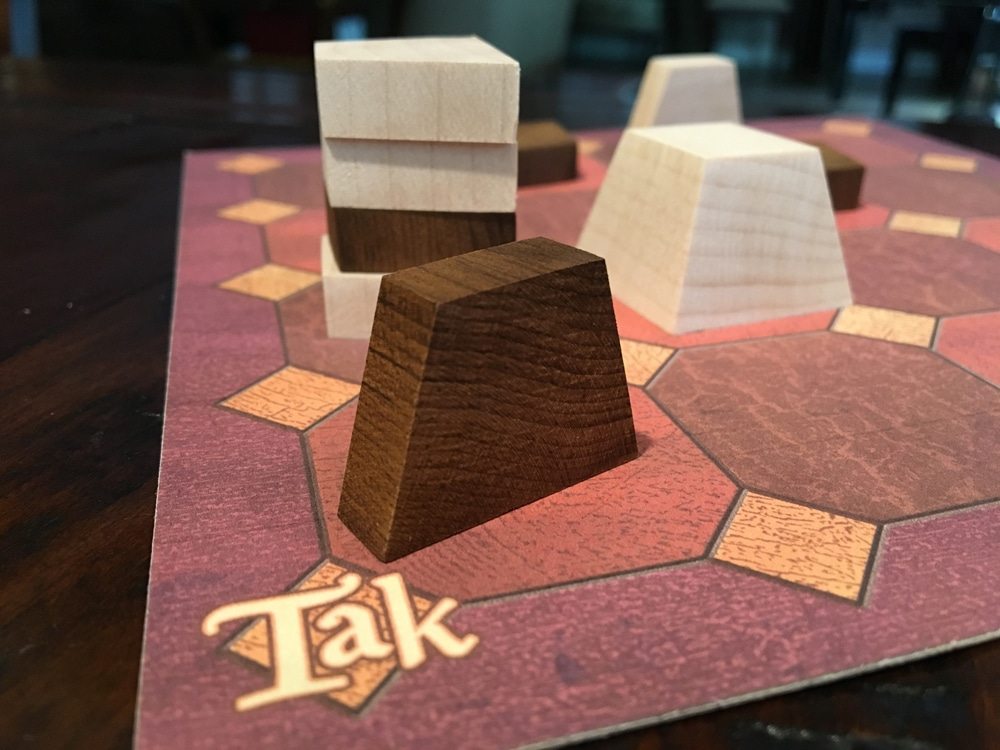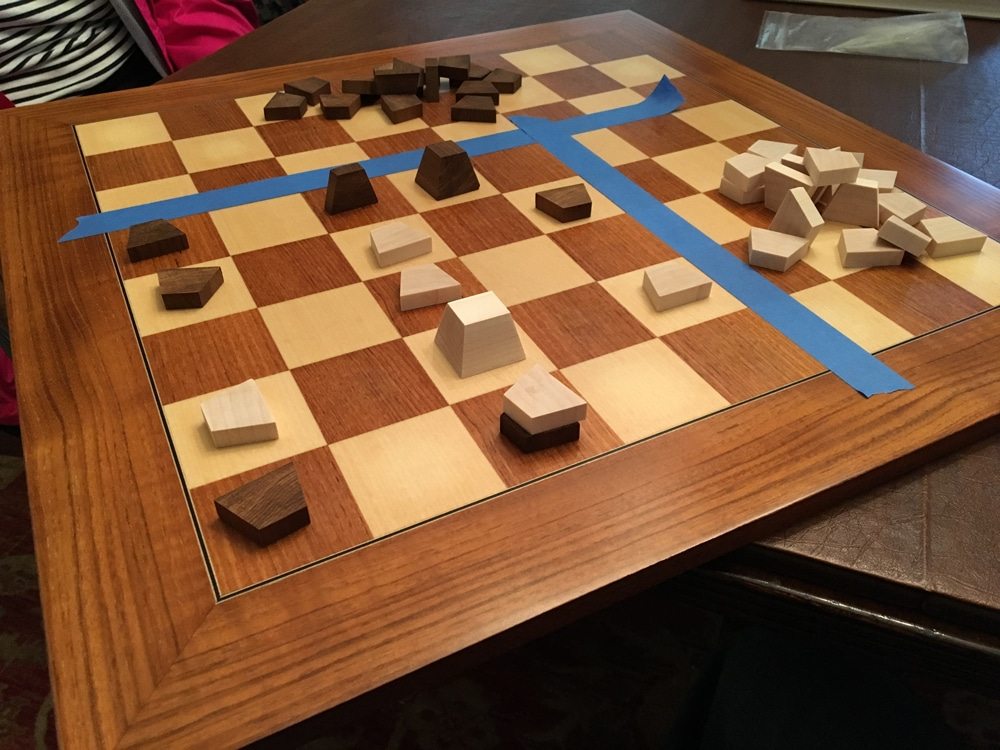
In Patrick Rothfuss’s The Wise Man’s Fear, the protagonist, Kvothe, talks about a game he learned while employed in a far-flung country. “My next several hours were spent learning how to play Tak. Even if I had not been nearly mad with idleness, I would have enjoyed it. Tak is the best sort of game: simple in its rules, complex in its strategy. Bredon beat me handily in all five games we played, but I am proud to say that he never beat me the same way twice.” As Kvothe learns, one of the goals of Tak seems to be to play “a beautiful game,” hinting even more strongly at the importance of strategy.
There’s not much more about gameplay of Tak in the book, but it gave spark to the desire to create a game that lived up to Kvothe’s description. Rothfuss hinted at bringing the game to life back in early 2014 and, sure enough, with the help of James Ernest, who designs abstract strategy games really well, the game slowly took shape. The result is a full blown game of Tak that launches today on Kickstarter and, like Kvothe says, it really is the best sort of game.

The Game
Tak borrows a bit from games like Go and Pente and has some similar mechanics to other Ernest games. The game can be played on different sized boards, from 3×3 all the way up to 8×8, and each presents a different experience because the pieces used and abilities change a little from setup to setup. While a physical board can be used to play the game, it’s not necessary. The center spot of an imaginary board can be marked with a coin and play can take place on any surface. This is a variant called “The Traveler’s Game.”
The rules for Tak are enjoyably written to allude to past versions of the game and historical play, creating a pedigree for the game that gives players the illusion that they are enjoying a pastime as old as a game like chess. The goal of Tak is to create a road from one side of the board to the other. The road can be horizontal or vertical and it needn’t be straight, it can take a detour, but it must be continuous and pieces must be adjacent, diagonal does not count in Tak‘s moves or roads. There are also conditions for winning if all stones have been used or the board is covered and no road has been completed.
There are two types of pieces in the game–regular stones and capstones. Play begins in the first round by each player placing one of their opponent’s stones and then continues by alternating turns until the game is over. On your turn you may place one of your stones or capstones in any empty space. Regular stones may be placed flat or standing up, forming a wall. Standing stones, or walls, do not count in a road.
Alternately, you may move a stone or stack of stones that you control (you control if your stone is on top of a stack). As you move a stack, you must leave one or more stones behind on each space you visit, reminiscent of Ernest’s Veritas. When moving a stack, you may only carry as many stones as the width of the board (five stones in a 5×5 game). A capstone or a wall may not have any pieces stacked on them, but a capstone can move onto a wall, which will flatten it. As mentioned, all of this is a bit abstract. However, once you see a game played, it becomes immediately apparent how deep and strategic Tak is.
In the 6×6 “Court” version of the game, players are encouraged to call “Tak” when a win seems imminent, the game’s version of “check.” Further, players allow their opponents to reverse moves when they were clearly mistakes–a far more civilized version than the cutthroat 5×5 “Tavern” version. An 8×8 “Master’s” game is considered the pinnacle of play. In the 3×3 and 4×4 game, capstones are not used (be mindful of setting walls, they can’t be flattened!) and the number of regular stones increases depending on board size.

The Campaign
The Kickstarter begins today and runs through May 20. You can read more about the game on Ernest’s site, play online, or print & play a board and try out a few games yourself. You can back the project at seven different levels, from a simple “thanks” from the creators, all the way up to a full game, a book, and a collector’s coin. If you back a a version with the board, it’s a unique hybrid system. For example, in the photo below, the large squares are used if playing 4×4 and the smaller diamonds are used to play 5×5.
There aren’t any stretch goals to begin the campaign, but there are designs for a wooden game board (instead of cardboard), capstones in different designs, and pieces made from different materials. The campaign pieces are made from white birch and are either trapezoids or flat-bottomed circles.
(Images in this post are from a pre-campaign set I was sent to test and are not representative of the rewards in the campaign.)

Verdict
I’ve only played a dozen or so games of Tak so far, but I really enjoy it. The rules are simple to learn, however, I see the game as a new classic that will take some time to master. I am really looking forward to challenging friends and developing my own attacks and figuring out how to react to their strategies.
I love how there are so many variations right away, both in board size and pieces and rules. But, no matter what size board you play on, every move is important. I’ve only had Tak on my table for a few days, but it’s already become a bit of an obsession. I keep thinking of moves and strategies I want to test. Not only is Tak fantastic, it gives me something to do while I wait for book three of The Kingkiller Chronicle.




